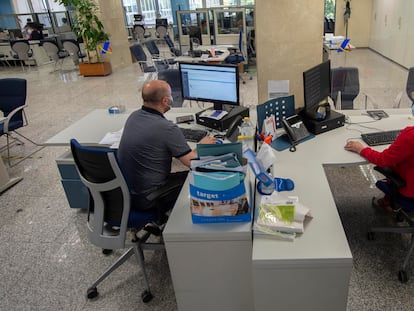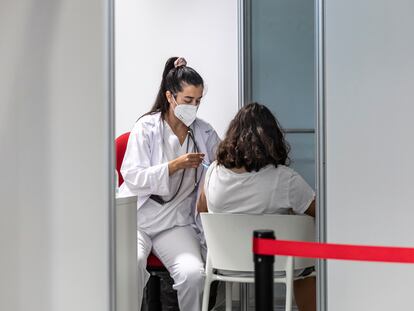As coronavirus transmission continues to fall, Spain moves out of ‘high risk’ level
The cumulative incidence of the virus over 14 days has fallen below 150 points for the first time since July 1

After more than two months, Spain is once again at the “medium risk” level in terms of the transmission of the coronavirus. According to the latest Health Ministry report, which was released on Thursday evening, the 14-day cumulative number of coronavirus cases per 100,000 inhabitants now stands at 140.43, having fallen below the high-risk level of 150 for the first time since July 1. The fifth wave of the pandemic in Spain continues to subside, leaving the country in a seldom-seen situation over the past year: just 70 of the last 365 days have been outside of the high or very high risk of infections, during two short periods at the beginning and the end of the spring, either side of the fourth wave.
These figures only refer to the likelihood of transmission. To calculate the global risk, each territory must be taken into account, as well as the cumulative incidence, other transmission indicators and statistics such as hospital and intensive care unit (ICU) occupation levels. On a national level, the figures are also at medium risk in terms of the ICUs, with less than 14% occupation by Covid-19 patients, and low in regular wards, with less than 5% occupation.
The downward trend of all of the indicators in the pandemic is generalized in all of the regions, but nine remain at high risk
These figures are also falling. Since August 2, there have been progressively fewer Covid-19 patients in Spanish hospitals. On Thursday, there were 5,115 patients in normal wards, which is half of the peak during the fifth wave. In the ICU, there were 1,257 patients. This data point is falling more slowly: on August 9, the day with the highest occupation levels, there were as many as 2,031 ICU patients.
There is also a progressive fall in the number of deaths in the Health Ministry data. While these numbers take weeks to settle, the trend is now clear, with a slow fall in the daily reported Covid-19 fatalities as well as the weekly figures according to date of death.
The downward trend of all of the indicators in the pandemic is generalized in all of the regions, but nine remain at high risk: Aragón, Balearic Islands, Cantabria, Castilla-La Mancha, Extremadura, Madrid, Navarre, the Basque Country and La Rioja. The best data are in Asturias, which has a cumulative incidence of 56. This region also has the highest percentage of its population with the full protection offered by the vaccines: 81.1%.
Given the fall in infections, most of Spain’s regions are progressively lifting social restrictions. Catalonia, for example, will lift all measures that still affect fundamental rights, such as the number of people at social meetings. It will, however, maintain capacity limits in hospitality venues.
Will transmission continue to fall?
The fall in infections is likely to be maintained over the coming days. It’s impossible to know with any certainty what the epidemiological curve will do, but the incidence over the last seven days – 52 cases per 100,000 inhabitants – is well below half that of 14 days. Even though it has limitations, in particular due to the delay in the notification of infections, this indicator sets the trend of what will happen to the 14-day cumulative incidence, the standard reference point for monitoring the epidemic in Spain: if it is below half then the future trend is likely to be a fall, and if it is above there will be a rise.
What will happen in the coming days will depend in part on the effect of people returning to the workplace and the start of the new school year. A few weeks will have to pass before it can be seen whether or not this has caused a rise in infections. By then, the percentage of the population that is fully vaccinated will be around 75%, including the majority of adolescents. This will make the spread of the virus more difficult, albeit not impede it fully, given that those who have been vaccinated can still be infected. But above all, it will mean that hospitalizations are ever more rare.
The under-12s are still yet to be vaccinated, and for now there is no vaccine that has been approved for this group. The two main pharmaceutical groups that are supplying Spain, Pfizer and Moderna, are carrying out trials and will adjust the dosage for children. By the end of the year they are likely to have finished their work checking whether the vaccines are safe and effective for this age group, something that is likely to be complete by the end of this year. Then the health authorities will have to decide whether to administer the vaccine, given that serious complications from Covid in children are very unlikely.
Meanwhile, similar measures will remain in place in schools as last year, such as masks for the over-sixes. That said, there will be more students per class than last year, and the more-contagious delta variant of the coronavirus is now circulating.
Fernando Simón, the director of the Health Ministry’s Coordination Center for Health Alerts (CCAES), held a conference on Thursday at the yearly meeting of the Spanish Society of Epidemiology (SEE), in which he pointed to Spanish schools’ successful management of the coronavirus. “We have been the only country in Europe and one of the few in the world that managed to keep the school year practically 100% face-to-face,” he said.
Experts such as the epidemiologist and pediatrician Quique Bassat trust that they can repeat that success, while others are more pessimistic and believe that given children are unvaccinated, they may end up causing a sixth wave that is passed on to older people, as happened during the fifth wave with young adults and adolescents.
In the last wave, as well as having the delta variant, we relaxed the measures greatlyElena Vanesa Martínez, president of the Spanish Society of Epidemiology
Simón argued, however, that any new wave would be much milder than previous ones. “It’s very likely that Spain will not have any more major epidemiological waves,” he said yesterday. “There could be a sixth, seventh, eighth or ninth wave, but they won’t be like the others.” The CCAES director said he was in favor of “beginning to normalize the disease,” albeit keeping certain measures in place and monitoring the curve of infections.
As well as having fewer cases, the majority of experts are also predicting new, milder waves. The fifth wave displayed a death rate that was seven times lower than the previous ones thanks to the vaccine campaign. That wave saw a faster rise of infections detected than in any other (in the first, infections likely went up faster but were not detected due to limits on testing). The pressure on hospitals, however, never threatened capacity during that wave. With more of the population protected by the vaccines, the more likely it is that the virus cause less-serious illness.
Elena Vanesa Martínez, the president of the SEE, thinks the same. “In the last wave, as well as having the delta variant, we relaxed the measures greatly,” she explained. “I get the impression that people are conscious once again that we have to respect the measures and we have the advantage that the more that the transmission falls, the more effective the measures will be. This is why she believes that any new wave will be minor. But, she warns, “there are still vulnerable groups who have not had access to the vaccine [for example, irregular immigrants], and despite all the population that has been vaccinated, if the virus reaches them it will propagate, which is why we have to continue to reach them.”
English version by Simon Hunter.
Tu suscripción se está usando en otro dispositivo
¿Quieres añadir otro usuario a tu suscripción?
Si continúas leyendo en este dispositivo, no se podrá leer en el otro.
FlechaTu suscripción se está usando en otro dispositivo y solo puedes acceder a EL PAÍS desde un dispositivo a la vez.
Si quieres compartir tu cuenta, cambia tu suscripción a la modalidad Premium, así podrás añadir otro usuario. Cada uno accederá con su propia cuenta de email, lo que os permitirá personalizar vuestra experiencia en EL PAÍS.
¿Tienes una suscripción de empresa? Accede aquí para contratar más cuentas.
En el caso de no saber quién está usando tu cuenta, te recomendamos cambiar tu contraseña aquí.
Si decides continuar compartiendo tu cuenta, este mensaje se mostrará en tu dispositivo y en el de la otra persona que está usando tu cuenta de forma indefinida, afectando a tu experiencia de lectura. Puedes consultar aquí los términos y condiciones de la suscripción digital.
More information
Últimas noticias
Chris Martin, Taylor Swift, Elijah Wood and other famous wedding ‘crashers’
‘How does it feel to be a failure?’: Elizabeth Berkley’s journey from ‘Showgirls’ ridicule to vindication
The story of the Málaga virus: The code that haunted Google’s cybersecurity center director for 30 years
The impact of Ecuador’s mega-prison: A polluted river, cleared forests and military checkpoints
Most viewed
- Christian Louboutin: ‘Young people don’t want to be like their parents. And if their parents wear sneakers, they’re going to look for something else’
- The low-cost creative revolution: How technology is making art accessible to everyone
- Liset Menéndez de la Prida, neuroscientist: ‘It’s not normal to constantly seek pleasure; it’s important to be bored, to be calm’
- All the effects of gentrification in one corner of Mexico’s Colonia Roma
- December Social Security and SSI payments: Dates, double checks and the 2026 COLA increase











































